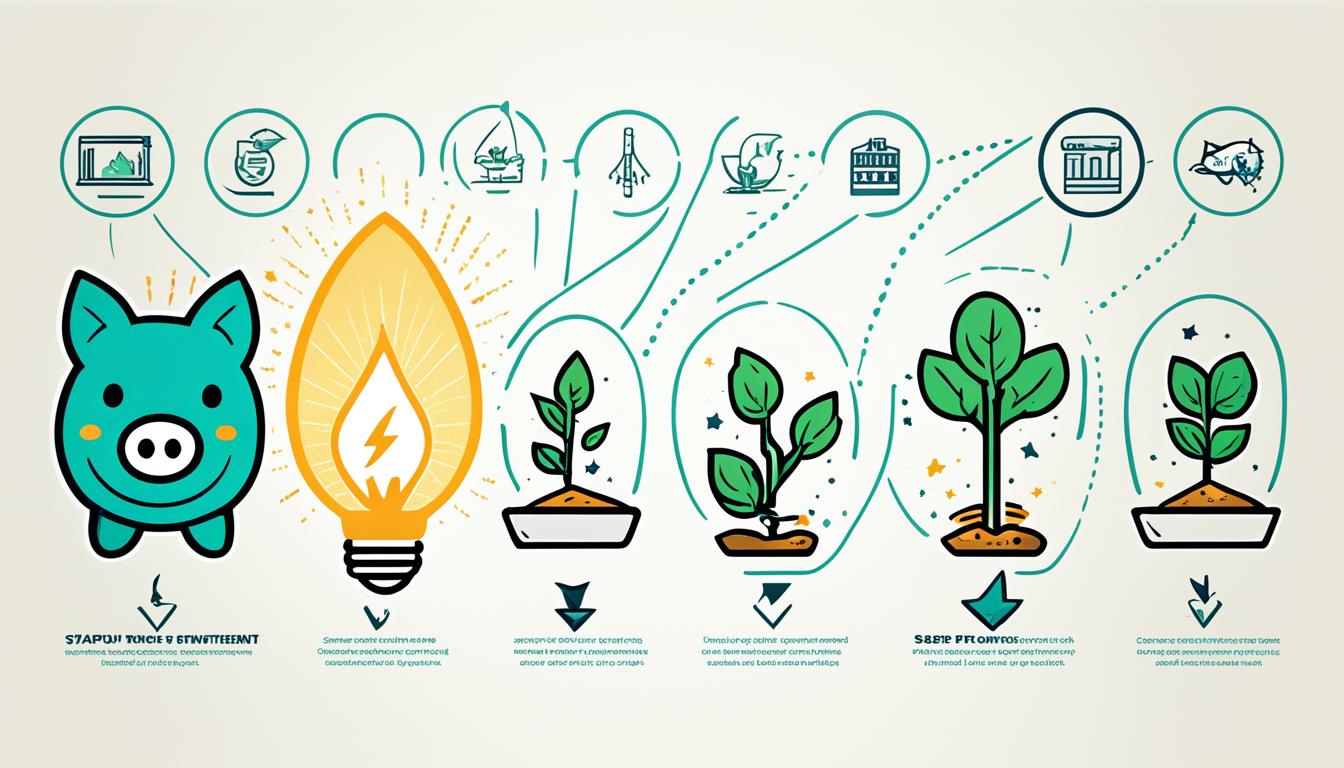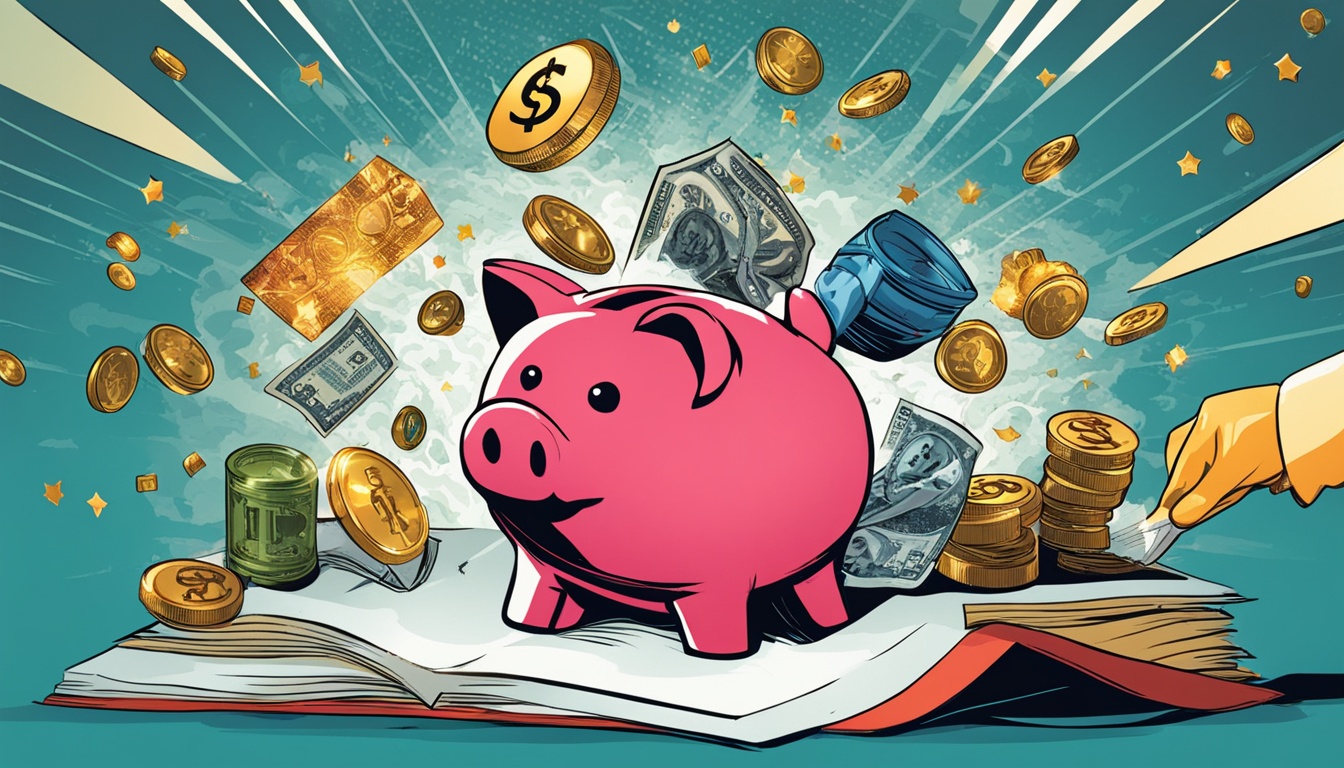Did you realize that approximately 29% of startups fail due to insufficient funding at the beginning? This statistic highlights the importance of entrepreneurs being familiar with various funding stages. Transitioning from Pre-Seed to Initial Public Offering (IPO) is crucial for success when seeking funding. Securing the right funding can accelerate your venture’s growth, providing the necessary financial resources and strategic guidance.
In this guide, you’ll learn the different ways to get funding, like bootstrapping, angel investors, and venture capital. Each funding stage offers its own chances and challenges. To thrive, it’s vital you understand these stages well. Knowing about startup funding can help you make smart choices and stand out in a crowded market.
Key Takeaways
- Startup funding stages include Pre-Seed, Seed, Series A, Series B, Series C, and IPO.
- Seed funding is key to a business’s early growth.
- Knowing your business’s value at each funding round can attract the right investors.
- The funding world has different players, including angel investors and venture capital firms.
- Getting Series A funding is important for startups that want to grow and gain market share.
- Knowing about different investors is crucial for making important connections.
Understanding Startup Funding Stages
Securing funding is a key event in a startup’s life. Most startups fail—47%—due to not having enough money. This fact shows how crucial funding is to turn new ideas into real businesses.
The Importance of Securing Funding
Funding helps test if your idea will work, develop your product, and pay for operations. Without it, good ideas won’t get off the ground. Startups need to attract investors at all stages to grow and succeed.
How Funding Fuels Growth
Funding supports different parts of your business. The early money usually goes into making your product. Later funding helps grow your company. Knowing how to use funding gives you an edge. It helps navigate finance challenges and grow steadily.
What Are the Different Stages of Startup Funding
Understanding the various funding stages is essential for startups. Each phase offers unique challenges and opportunities. It reflects the growing needs of a business. From the start to going public, knowing each stage helps in making smart decisions.
Overview of the Funding Journey
The journey begins with pre-seed funding. Entrepreneurs often use personal savings, family, and friends’ help. They may gather $25,000 to $500,000 at this stage. As the startup grows, it moves to the seed stage. This is where angel investors or venture capitalists come in. Startups might get a few thousand dollars to several million.
After that, startups enter early-stage funding, like Series A and B. The funding can be between three million and $30 million. Venture capitalists mainly invest at this stage. They help startups market products and gain customers. Late-stage financing, including Series C, can rise up to $100 million. It allows companies to grow and improve their products.

Valuation at Each Stage
Valuation is critical during the funding process. It affects how much investment startups can get. There are different ways to assess a startup’s worth. This decides what investors will offer in terms of money and ownership. Early on, valuations are small. But by Series A, they could be between three to twenty million. With growth, Series B might bring about $30 million. Series C valuations could hit $100 million or more. Knowing these valuations helps in planning your company’s path.
Pre-Seed Funding
Pre-seed funding is the start of your startup’s financial journey. It helps entrepreneurs get the resources they need. This phase is about validating your idea and getting ready for bigger investments. It’s also when you build a great team and create a product to show to the market.
Defining the Pre-Seed Stage
Funding at this stage usually goes from $50,000 to $250,000. It lets entrepreneurs test their ideas. Pre-seed investors fund based on the vision and a prototype. Founders need a great business plan and a strong team to get investment.
Funding Sources: Family, Friends, and Angel Investors
There are many ways to get pre-seed funding. Family and friends can be a good source if they believe in your idea. Angel investors also provide support and focus on early-stage companies. Accelerators and incubators help, too. There are even funds like Hustle Fund and Forum Ventures that support new ideas.
What You Need to Prepare
Getting ready for pre-seed funding is critical. Make sure you have a detailed business plan. It should show your vision, who your customers are, and how you stand out. Doing deep market research is important, too. Investors want to see that your product meets a market need. Showing early customer interest makes your startup more attractive.

Seed Funding
Seed funding is a crucial step for startups. It shifts ideas into practical business plans. This stage is often the first real financing round. It lets entrepreneurs get early equity funding. This helps them build on what they started in the pre-seed stage. By getting seed funding, you can push your idea towards reality.
The Transition from Idea to Execution
Moving from an idea to execution needs a solid strategy and a working product prototype. You must clearly know what you will offer the market. Have a working product and a group of potential customers. In 2023, startups worldwide got about $60.5 billion in funding. This shows how crucial it is to get investment at this stage.
Identifying Potential Investors
Finding the right investors is crucial for your startup. Seed funding comes from various sources like seed funds, angel investors, and venture capitalists. These investors are ready to bet on new businesses. Building good relationships with them can help you financially.
Risks of Seed What Risks Involved?CallableWrapper.placeholder
Investment risks.
It’s crucial to think about the risks when seeking seed funding. About 29% of startups fail early on, often from not having enough money. Knowing these risks helps you better prepare. This preparation increases your chance of getting the funding you need to succeed against others.
| Funding Stage | Valuation Range | Typical Funding Amount |
|---|---|---|
| Pre-Seed | $10,000 – $100,000 | Personal financing, family, and friends |
| Seed | $3 million – $6 million | $50,000 – $3 million |
| Series A | $10 million – $30 million | $15 million |
| Series B | $30 million – $60 million | $30 million |

Series A Financing
Getting Series A financing is a big deal for startups. It means they’re moving from starting out to growing fast. This money often comes from venture capitalists. They put money into startups that look promising. Startups aim to get between $1 million to $15 million. This cash is for product development, marketing, and growing the company.
Understanding Series A Investments
Investors look at what the startup has done, its plan for growth, and how it stands out in the market. It’s important to tell a strong story in your business plan. This shows how you’ll make money in the long run. Investors want to know that the startup will grow.
Criteria for Series A Funding
To get Series A investors interested, certain criteria must be met.
- A solid performance record of your product.
- Evidence that people want your product and that it’s better than others.
- A clear plan for making your operations bigger.
- Financial plans that show how the company can grow.
Making these points clear can help a lot in getting the money you need.
Investor Expectations
Investors look for more than just making their money back. They want to be part of the startup’s growth. They usually want:
- About a 5% to 10% share of the company for their money.
- To know how the business is doing and what challenges it faces.
- To help make big decisions, especially about growing the company.
It’s key to understand and meet these expectations to keep a good relationship with investors.

| Funding Stage | Typical Investment Amount | Valuation Range |
|---|---|---|
| Series A | $1 million – $15 million | $10 million – $30 million |
| Series B | $15 million – $25 million | $25 million – $60 million |
| Series C | Varies, often higher | Typically investors seek established companies |
Series B Financing
When your startup grows, getting Series B funding is key to expanding further. This stage is for companies that have shown they’re successful in the market and are ready to grow more. Making it through this part well can lead to a lot of growth for your business.
When to Seek Series B Funding
Think about Series B funding when your startup makes good money and has many users. By now, you should be past the initial thrill of Series A and have met important goals. If you’re ready to grow your business and reach more customers, it’s time for Series B financing.
Goals for Series B Round
Your goals in the Series B round should be to grow your business operations and invest in understanding the market better. Using funds in these areas can help you meet your goals of expanding. You can improve what you offer and how you engage with customers. Aim to increase your place in the market, introduce new products, or enter new areas.
Challenges in Series B Financing
Series B financing comes with its challenges, despite its advantages. You must keep innovating to stay ahead in a competitive market. Strong marketing is vital to attract new and keep existing customers. Facing these challenges is crucial for your startup’s long-term growth after getting funded.

Series C and Beyond
Series C funding is key for startups looking to grow fast. This stage can bring in $30 million to $100 million. Investors now expect a lot. They want to see businesses with solid success and a plan to get bigger. Startups often use this money to make new products, go into new markets, or buy other companies.
What to Expect from Series C Funding
Getting to Series C funding is a major step. Investors are looking for a strong fit between product and market, plus steady money coming in. They will take a close look at startups, checking their growth potential. Things like how much money the startup makes and if it’s profitable are key to attracting investors.
Evaluating the Need for Further Series Rounds
Thinking about more funding rounds? It depends on a few things. These include your startup’s success so far and the chances out there. If you’re hitting your growth goals and have a good plan, more funding might improve your position. Careful planning is crucial to make the best of any more money you get.
Potential Investors in Series C
Investors like private equity firms and banks come into play during Series C. They’re interested in startups that have done well so far and have plans for more growth. Knowing what these investors want is important. Your startup needs to show big achievements in things like gaining more market share and making more money.

Initial Public Offering (IPO)
An Initial Public Offering (IPO) is a big event for startups, allowing them to get money from public investors. It’s key for entrepreneurs to grasp the IPO journey. This journey includes meeting with regulatory standards, prepping financial statements, and working with underwriters for selling shares. Mastering this process can open up huge funds for growth and expansion.
Understanding the IPO Process
The ride through an IPO can be complex, needing a lot of prep. Companies must show a solid business plan, financial strength, and steady income generation. First off, they pick an investment bank to guide them. This bank helps set the stock price, gets the paperwork ready, and markets the stock. It’s vital to be open and stick to rules set by the Securities and Exchange Commission.
Benefits and Drawbacks of Going Public
Going public has big benefits. It lets companies get a lot of money, become more known, and draw in skilled workers. This step also boosts credibility, making it easier to get more financing later. However, it also means more eyes from investors and regulators, which can reduce the founders’ control. Plus, the cost of going through with an IPO, like legal fees and the need for continuous reporting, can be hefty.
Investor Impact During IPO
How investors react during an IPO can greatly affect the company’s market position. Their expectations might change based on past funding events. So, it’s key to keep investors happy and positive. A successful IPO can lead to more investment and pave the way for growth. But, if it doesn’t hit the market’s hopes, it could make the startup less stable and impact its chance to raise money later.

Navigating the Investor Landscape
It’s vital for startups to understand the investor scene to get funding. Knowing different investors helps you find right partners. Angels, venture capitalists, and crowdfunding each play unique roles in funding.
Identifying Different Types of Investors
Investors have specific roles in supporting your business:
- Angel Investors: Wealthy folks offering money for startups, usually for debt or equity.
- Venture Capitalists: Groups investing from pooled funds in promising startups, targeting high growth.
- Crowdfunding Platforms: Online spaces for entrepreneurs to get funding from many people in small amounts.
Building Relationships with Potential Investors
Creating strong ties with investors means knowing what they look for. This includes:
- Matching their investment focus with your business goals.
- Being open and honest builds trust and credibility.
- Keeping them updated on your progress to nurture a successful partnership.
Choosing the Right Investor Fit
Finding an investor who shares your vision is key. Here’s what to consider:
| Criteria | Angel Investor | Venture Capitalist | Crowdfunding |
|---|---|---|---|
| Investment Amount | $50,000 to $2 million | $3 million to $25 million | Varies widely |
| Level of Involvement | High | Moderate to High | Low |
| Preferred Stages | Seed and early-stage | Series A, B | All stages |

Choosing the right investor boosts your chance to secure funds. Knowing the investor field helps build key relationships for your startup’s growth.
Conclusion
As we wrap up, think about how each funding stage impacts your business journey. Knowing about pre-seed to IPO stages helps you navigate funding paths. It prepares you for raising money from different sources as your business grows.
This article shared key funding success strategies. Understanding the details of each funding round helps you attract the right investors. Good relationships with these investors can really boost your startup.
In closing, use the insights from each funding stage to move boldly into the startup world. Clearly sharing your vision helps get the funding you need. It also builds important connections that can drive your business to success.









